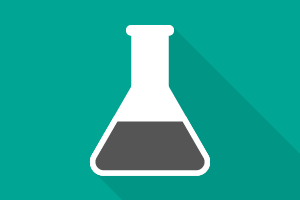Classroom Resources: States of Matter
Filter by:
1 – 16 of 16 Classroom Resources
-

Colligative Properties, Boiling Point Elevation, Freezing Point Depression, Concentration, Solute & Solvent, Boiling Point, Freezing Point, Phase Changes, Molecular Motion, Graphing, Physical Properties, Heat, Temperature | Middle School, High School
Activity: Simulation Activity: The Effect of Solutes on Boiling and Freezing Point Mark as Favorite (33 Favorites)
In this activity, students will use a colligative properties simulation to investigate the effects of different solutes, and different amounts of those solutes, on the boiling point and freezing point of a solution. Students will see particle-level animations of boiling and freezing with different types and amounts of solutes, as well as graphical representations of the results of each trial.
-

Freezing Point Depression, Heat, Phase Changes, Molecular Motion | Middle School, High School
Lab: Sweet, Salty and Cold as Ice Mark as Favorite (28 Favorites)
In this lab, students conduct a micro-scale investigation to explore how various solutes affect the freezing point of water. Because of the small volume of liquid used, results are visible within minutes. Students observe what happens to the liquids as they are cooled and use their observations to infer what is going on at the particle level. They will use the results to explain the familiar phenomena of why we salt our roads and sidewalks in the winter and why freshwater lakes and ponds freeze over more easily than saltwater oceans in the winter.
-

Molecular Motion, Phase Changes | Middle School
Activity: Atoms in Motion Mark as Favorite (17 Favorites)
In this activity, students will explore how particles that make up matter are in constant motion. The students will use an online PhET simulation to compare the ways that atoms and molecules move in samples of solids, liquids, and gases. This activity will help students improve their understanding of the particle level.
-

Phase Changes, Molecular Motion | Middle School, High School
Simulation: States of Matter and Phase Changes Mark as Favorite (105 Favorites)
In this simulation, students will participate in a 10 question quiz. Some questions will challenge students to analyze data to identify the correct state of matter for a specific sample, and then connect the chosen state with an animated particle diagram. In addition, students will examine the behavior of particles in an animated sample as they undergo a phase change, and must correctly identify the change that occurs.
-

Phase Changes, Molecular Motion | Middle School, High School
Activity: Simulation Activity: States of Matter and Phase Changes Mark as Favorite (65 Favorites)
In this simulation, students will participate in a 10 question quiz. Some questions will challenge students to analyze data to identify the correct state of matter for a specific sample, and then connect the chosen state with an animated particle diagram. In addition, students will examine the behavior of particles in an animated sample as they undergo a phase change, and must correctly identify the change that occurs.
-

Molecular Motion, Physical Properties | Middle School, High School
Activity: Categorizing States of Matter Mark as Favorite (100 Favorites)
In this activity students will analyze both written statements and images that describe the properties of a solid, liquid or gas. Students will determine which state of matter the description best describes and categorize it accordingly.
-

Heat, Temperature, Specific Heat, Observations, Molecular Motion | High School, Middle School
Activity: What Makes Something Feel Warm Mark as Favorite (57 Favorites)
In this lesson students actively engage in thinking about energy issues in chemistry and the nature of energy (thermal) transfer. The idea that temperature is a measure of heat content will be challenged, and students will be given the opportunity to collect data that will allow them to clearly see that different materials transfer energy at different rates.
-

Temperature, Molecular Motion, Observations, Inferences | High School, Middle School
Demonstration: What is Temperature? Mark as Favorite (60 Favorites)
In this demonstration, students will observe food dye mixing with water at different temperatures.
-

Heating Curve, Phase Changes, Intermolecular Forces, Freezing Point, Melting Point, Boiling Point, Heat of Fusion, Heat of Vaporization , Molecular Motion, Temperature, Heat, Specific Heat | High School, Middle School
Activity: Simulation Activity: Heating Curve of Water Mark as Favorite (90 Favorites)
In this simulation, students will investigate qualitatively and quantitatively what happens as water changes states.
-

Pressure, Gas Laws, Kinetic Molecular Theory, Temperature, Volume, Molecular Motion, Intermolecular Forces | High School, Middle School
Lab: Gas Pressure Mark as Favorite (39 Favorites)
In this lab, students will understand what causes pressure in a container and the variables that affect pressure (volume, temperature, number of moles) by mimicking molecular motion of gases.
-

Kinetic Molecular Theory, Pressure, Gas Laws, Volume, Temperature, SI Units, Molecular Motion | High School, Middle School
Activity: Simulation Activity: Gas Law Variables Mark as Favorite (5 Favorites)
In this simulation, students investigate variables of a gas. From the computer models, they can see how pressure, temperature, and volume effect gas behavior.
-

Molecular Motion, Intermolecular Forces | High School, Middle School
Activity: Simulation Activity: Molecular Motion Mark as Favorite (0 Favorites)
In this simulation, students will have the opportunity to explore on the molecular level how particles move in three states of matter. They will compare two different substances.
-

Molecular Motion, Heat, Phase Changes, Melting Point, Heating Curve, Freezing Point, Temperature, Graphing | High School, Middle School
Lesson Plan: Modeling the Melting of Ice Mark as Favorite (33 Favorites)
In this lesson, students will create a particulate model of matter that explains energy changes and transfer during a phase change.
-

Molecular Motion, Density, Physical Properties, Density, Gas Laws, Ideal Gas, Temperature, Pressure, Volume | Middle School, High School
Simulation: Density Mark as Favorite (13 Favorites)
The simulation for the September 2015 issue allows students to investigate the effect of changing variables on both the volume and the density of a solid, a liquid, and a gas sample. Students will analyze the different states of matter at the particle level as well as quantitatively.
-

Density, Molecular Motion | Middle School, High School
Activity: Simulation Activity: Density Simulation Mark as Favorite (28 Favorites)
In this simulation, students will investigate the effect of changing variables on both the volume and the density of a solid, a liquid and a gas sample. Students will analyze the different states of matter at the particle level as well as quantitatively. This lesson accompanies the simulation from the September 2015 issue of Chemistry Solutions.
-

Heating Curve, Phase Changes, Intermolecular Forces, Freezing Point, Melting Point, Boiling Point, Heat of Vaporization , Molecular Motion, Temperature, Specific Heat, Heat, Heat of Fusion | Middle School, High School
Simulation: Heating Curve of Water Mark as Favorite (50 Favorites)
In the May 2015 issue, students explore the heating curve for water from a qualitative and quantitative perspective. Students compare illustrations of each physical state depicted on the curve and calculate the energy required to transition from one state to another.